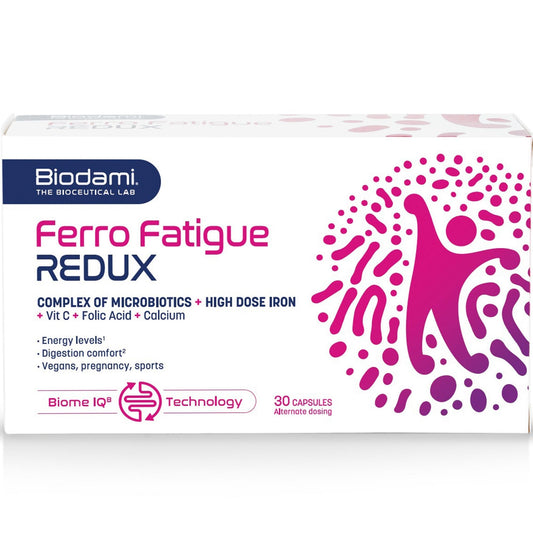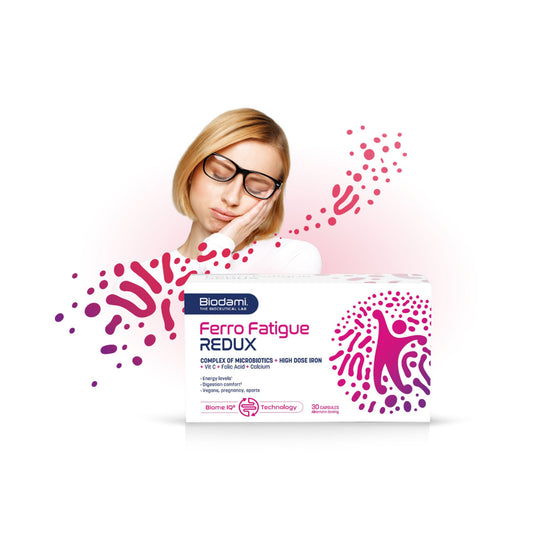Iron is an essential element involved in many biochemical processes in our body, in particular oxygen transport to the tissues and the formation of red blood cells. It is however the nr. 1 nutrient deficiency in both developed and developing countries.
To fully understand the importance of iron in our bodies, it is essential to provide some basic information on iron metabolism.
Iron uptake mechanisms
Iron supplied from the food passes through the stomach and as it reaches the duodenum part of the intestine, this is when the absorption of iron starts.
 The small intestine is lined with intestinal cells called enterocytes. These cells are the home of important proteins and transmembrane enzymes in iron metabolism.
The small intestine is lined with intestinal cells called enterocytes. These cells are the home of important proteins and transmembrane enzymes in iron metabolism.
- DYCTB: Duodenal cytochrome B- is a ferrireductase enzyme that transforms non-absorbable ferric to absorbable ferrous iron(Fe3+ to Fe2+).
- Once Fe2+ is formed, DMT1: Divalent Metal Transporter 1 comes into action. It is a protein that allows the transport of ferrous Fe2+ into the enterocytes. But free Fe2+ inside the cells is toxic and will and therefore need to be stored in a nontoxic form (in a complex protein called ferritin) or exported out of the cell into the blood circulation. This export is mediated by another transmembrane protein called FERROPORTIN.
- Once in the blood circulation, this ferrous iron (Fe2+) is actually not the transportable form and thus must be formed back into ferric iron (Fe3+) which is mediated by another protein called HEPHAESTIN.
- The Fe3+ iron then forms a complex with apotransferrin to form TRANSFERRIN, another protein that mediates the transport of iron through the blood, delivering iron to the cell while also limiting the formation of toxic radicals attributed to iron.
- In this complex, iron can be transported into the bone marrow for red blood cell formation or into storage in the liver. It is worth noting that iron storage is a critical component of cellular iron homeostasis/balance. It enables the iron to remain in the body in a non toxic form but also provides a reservoir from which iron can be used for future metabolic needs.
Fe2+ = ferrous iron ➡ absorbed form
Fe3+ = ferric iron ➡ cannot be absorbed
Iron levels are very tightly regulated with exquisite feedback mechanisms in the body, where it allows to maximize the iron supply when the cells are iron deficit. This means that the iron stored will be mobilized and there will be an increase in intestinal absorption.
But there is also a mechanism in which the iron supply is restricted in case of iron overload.
The era of hepcidin
In the early 2000’s scientists discovered a master regulator molecule in maintaining iron balance. This peptide hormone is called HEPCIDIN. It is predominantly produced by the liver and levels of it in our bodies are modified in response to either iron overload or deficit.
We have seen previously the transmembrane FERROPORTIN that is responsible for the export of Fe2+ into the blood stream. During iron overload, the hepcidin expression increases so that it blocks ferroportin action, disabling the export of Fe2+. During iron deficits the reverse happens. Hepcidin expression is low and ferroportin action high allowing the export of iron into the circulation.
Given the toxicity of iron, it makes sense that absorption from food is low, despite the very elegant regulatory mechanisms that secure iron balance in our bodies. Current solutions to compensate for the low natural absorption of iron from food or food supplements is to ingest very high dosages of iron in the form of ferrous salts. It is true that iron intake needs to be increased for those deficient, but scientists have shown that large doses of iron acutely increase serum hepcidin which persists for 24 hours, inhibiting iron absorption and increasing the unabsorbed iron in the gut which will cause the gut irritation iron supplements are known for. (read this article on iron and your gut) This makes the intake of higher doses futile.
Alternate dosing: a smarter way of iron supplementation
Alternate dosing revolutionizes iron supplement intake. Scientists have shown that giving our body a 24 hour rest between two high doses iron (100 mg and 200mg) intake is a more appropriate dosing regimen. By leaving 24 hours between doses, you can prevent the sustained hepcidin production, thereby maximizing iron uptake (up to 40%!) while also preventing the negative effects of high doses of iron on the microbiome and gut irritation.
Sophie Cochez
Sophie holds a master degree in medical biology, with particular focus on microbiology and biotechnologies. Passionated about health sciences, she had her first professional experience in a clinical research center, a CNRS unit (Centre national de la recherche scientifique) to develop her master thesis on "The use of antibody arrays to analyze human proteomes of cancer - and its perspective of application for breast cancer diagnosis". CNRS FRE 2230
References:
Abbaspour N, Hurrell R, Kelishadi R. Review on iron and its importance for human health. J Res Med Sci 2014;19:164-74.
Chifman, J., Laubenbacher, R., & Torti, S. V. (2014). A systems biology approach to iron metabolism. Advances in experimental medicine and biology, 844, 201–225. https://doi.org/10.1007/978-1-4939-2095-2_10
Rusu, I. G., Suharoschi, R., Vodnar, D. C., Pop, C. R., Socaci, S. A., Vulturar, R., Istrati, M., Moroșan, I., Fărcaș, A. C., Kerezsi, A. D., Mureșan, C. I., & Pop, O. L. (2020). Iron Supplementation Influence on the Gut Microbiota and Probiotic Intake Effect in Iron Deficiency-A Literature-Based Review. Nutrients, 12(7), 1993. https://doi.org/10.3390/nu12071993
Stoffel, N. U., Cercamondi, C. I., Brittenham, G., Zeder, C., Geurts-Moespot, A. J., Swinkels, D. W., Moretti, D., & Zimmermann, M. B. (2017). Iron absorption from oral iron supplements given on consecutive versus alternate days and as single morning doses versus twice-daily split dosing in iron-depleted women: two open-label, randomised controlled trials. The Lancet. Haematology, 4(11), e524–e533. https://doi.org/10.1016/S2352-3026(17)30182-5
Stoffel, N. U., Zeder, C., Brittenham, G. M., Moretti, D., & Zimmermann, M. B. (2020). Iron absorption from supplements is greater with alternate day than with consecutive day dosing in iron-deficient anemic women. Haematologica, 105(5), 1232–1239. https://doi.org/10.3324/haematol.2019.220830







